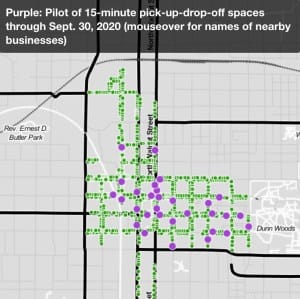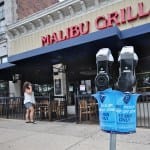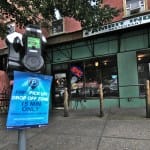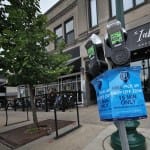15-minute free PUDO parking starts Aug. 1 in downtown Bloomington

During the COVID-19 pandemic, aversion to dine-in eating at restaurants or leisurely browsing inside retail stores has put a premium on finding a spot to park just for short while.
Patrons are looking to park just long enough to grab take-out food, or an item that’s been set aside by a store owner for quick pick-up.

One measure of the interest in alternatives to dine-in or in-store service is search interest on Google for the word “delivery.” It tripled in late March, compared to a month earlier.
The city of Bloomington announced this week that it will resume enforcement of parking meters on Aug. 1, after a few months of allowing people to park for free for two hours.
The city is also rolling out a pilot program to support those local businesses whose potential customers are more likely to become actual customers, if they have easier access to short-term parking.
Starting Aug. 1, at least through Sept. 30, some of the the downtown’s roughly 1,500 spaces with on-street parking meters will be converted to 15-minute free parking spots, meant for pick-up and drop-off purposes. The shorthand to describe the spaces is the acronym PUDO.
On Wednesday, Bloomington’s city council got a briefing about PUDOs from Kaisa Goodman, who is special projects manager for the city’s department of economic and sustainable development department.
Goodman described how the PUDO proposal is meant to help small businesses generate economic activity in spite of a recent surge of COVID-19 cases in the county. The idea of using designated short-term parking spaces for getting take-out food or just running into a store, is not an original idea, Goodman said. Bloomington’s approach is being modeled on what many peer cities cities have implemented during the COVID pandemic, Goodman said.
Goodman said the PUDO program was developed in consultation with the Greater Bloomington Chamber of Commerce, Downtown Bloomington, Inc. and individual businesses.
Goodman described how the PUDO spaces are distributed in 30 “zones” that were identified as good pick-up drop-off points, mainly near restaurants, but also retail establishments in the downtown corridor. Each zone was assigned one or two spaces, for a total of 54 total spaces.
A PUDO space will have signage that says it’s free to park for 15 minutes during metered hours. Parking meters are normally enforced from 8 a.m. to 9 p.m., Monday through Saturday.
On Wednesday, councilmembers were generally supportive of the idea.
Councilmember Dave Rollo was interested in getting some kind of report on the pilot program’s effectiveness.
Councilmember Matt Flaherty wanted to know how the effectiveness will be monitored—acknowledging that it might be difficult to measure how the PUDO spaces are being used. Still, he said, it would be useful to know if some spaces are underused and could be eliminated, or if usage in some area indicates that more PUDO spaces need to be added there.
Goodman said the chamber of commerce and Downtown Bloomington, Inc. would serve as conduits for feedback. Goodman said the city also expects to get feedback from merchants and patrons.
Councilmember Steve Volan suggested that sensors be installed in each space so that usage of individual spaces can be measured.
Councilmember Isabel Piedmont-Smith said she thinks PUDOs are a good idea. She wanted to know if there is any plan to implement “parklets”—extensions of sidewalks that give more space to use the street for other purposes besides driving and parking. That’s in the works, according to Goodman—she has just sent a memo to the administration on the topic of parklets.
The 54 spaces to be allocated to the PUDO program make up about 3.6 percent of the 1,511 spaces in the city’s GIS file of parking meters.
Based on the city of Bloomington’s online records of revenues to the parking meter fund, in the four years from 2016 to 2019, the city’s parking meters generated average annual gross revenue of about $2.56 million. Over those four years, the price for on-street metered parking remained at $1 per hour, the same as the current price.
Starting in 2019, the hours of enforcement were longer by one hour, starting at 8 a.m. instead of 9 a.m. So the calculated four-year average could be considered conservative.
Per space, that works out to about $1,700 in annual gross revenue per parking meter. So taking 54 spaces out of the revenue stream would reduce revenue to the parking meter fund by about $90,000 a year.
The parking meter fund was established as a part of local law in 2013, when parking meters were re-introduced into the downtown area.
Expenditures from the fund are restricted mostly to uses that give direct support to parking infrastructure—expenses related to acquisition and maintenance of meters, and expenses related to land acquisition for parking purposes. The money can also be spent on traffic signals generally.
Parking fund revenue can also be spent on repairing sidewalks in areas where parking meters are installed. Parking fund revenue can also be spent on providing “approved school crossing protective facilities.”
The news release from the city announcing the program stated: “The PUDO pilot has been approved by the board of public works to continue through September 30, after which it could be extended by temporary order or council vote.”
Recent meetings of the board have not included a PUDO-related item on the agenda. And director of public works Adam Wason confirmed to The Square Beacon that the proposal won’t be taken to the board of public works until next Tuesday. Under city code, the program can be authorized at the staff level for up to 180 days.
The city ordinance on that topic was amended in late 2018 to extend the authority for temporary orders, by the chief of police or the transportation and traffic engineer, from 90 days to 180 days.
[Updated on July 31, 2020 at 5:56 p.m. The signs marking the free 15-minute PUDO parking spots were zip-tied to parking meters Friday afternoon.]







Comments ()